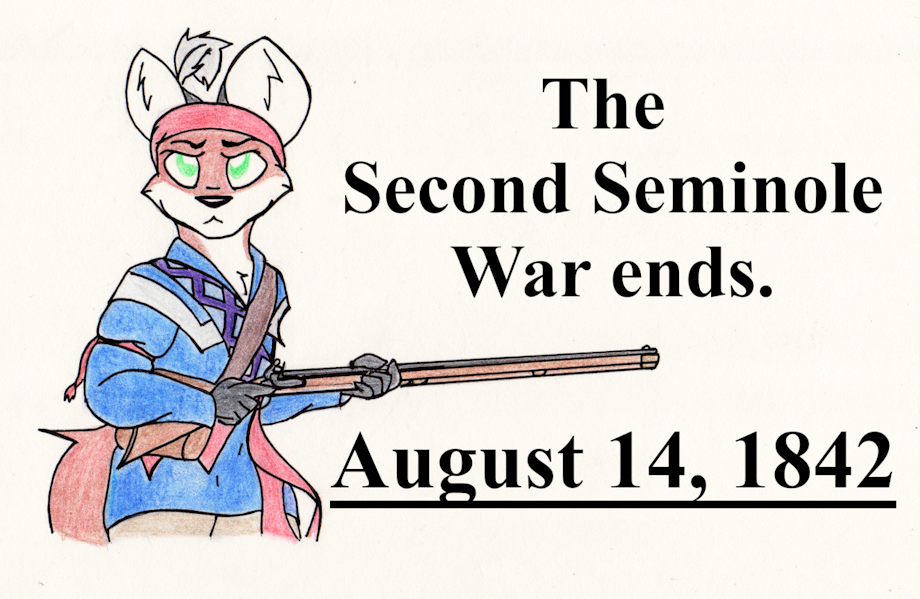On August 14, 1842, the Second Seminole War comes to an end. In the years before the war, the Seminole had been placed under pressure as other tribes (including Creeks, Choctaws, and others) had began settling territory in Florida. Furthermore, the United States had set its eyes upon Florida, which was a Spanish territory at the time, and eventually invaded Florida in the aftermath of the War of 1812, resulting in the First Seminole War which concluded with the US taking Florida from the Spanish. At the conclusion of the war, the Treaty of Fort Moultrie was signed between the Americans and the Seminole wherein the Seminole agreed to give up their lands in the northern part of Florida in exchange for a reservation in the center of the territory. However, tensions continued to grow as American settlers demanded that they be allowed to settle the land and that the Seminole be removed to new lands west of the Mississippi River in what would be known as Indian Territory (modern-day eastern Oklahoma). Another point of friction came from escaped slaves from the Southern states and from other tribes finding sanctuary among the Seminole. Under mounting pressure, the US government and the Seminole signed the Treaty of Payne's Landing in 1834. The Seminole agreed to relocate to the West on the condition that tribal representatives must find and agree upon suitable land first. Following a trip to the Indian Territory by the Seminole delegation, the American officials claimed that an area of land had been agreed upon; however, the men who had gone claimed that they had been coerced or, in some cases, hadn't signed the agreement to begin with. As relations further deteriorated between the Americans and the Seminole, many refused to leave their homeland. In response, the American official assigned to the task, Wiley Thompson, ordered the sale of arms and ammunition to the Seminole to banned. As the conflict began to escalate into violence from both sides, a Seminole warrior named Osceola emerged as a leader of the Seminole who sought to resist removal.
On December 23, 1835, 110 US soldiers left an American fort. Five days later, all but three were killed by the Seminole in the Dade massacre, propelling the conflict into full scale war that would become known as the Second Seminole War. On the same day as the massacre, Osceola and a group of his men also killed Wiley Thompson. Initially, the war favored the Seminole as the wore down the American forces sent to capture them, including defeating Major General Winfield Scott. However, the course of the war changed as Major General Thomas Jesup was assigned to put down the Seminole rebellion in 1837. Seminole forces began suffering greater losses began to rise and many, seeing little in the way options, surrendered and agreed to removal. Jesup also utilized deceit by arranging truce talks and then arresting those who came. This includes Osceola, who was captured by Jesup despite arriving under a white flag for a peace talk agreed to by Jesup. Osceola would die withing three months while still imprisoned by the US Army.
In 1838, Jesup requested permission for the US government to allow the few remaining Seminole (~500 people) to remain in Florida south of Lake Okeechobee as he felt waging a campaign in such terrain would be too costly. After he was denied permission to do so, Jesup asked to relieved of his command. He was then replaced with General Zachary Taylor, who focused his efforts on keeping the Seminoles out of northern Florida. Over the next few years, other generals would take over command of the American forces as the remaining Seminole fought desperately to remain in Florida. On August 14, 1842, then-commander of the US forces in Florida Colonel William Jenkins Worth declared victory in the Second Seminole War. No formal peace treaty had been signed, but ~4,000 Seminoles had been removed to the Indian Territory. An estimated 300-350 Seminole remained in Florida and were to be allowed to remain so long as they stayed in southern Florida. Tensions between the Seminole in Florida and white settlers would continue, eventually resulting in the Third Seminole War in 1855.
Keywords
male
1,207,897,
fox
249,726,
anthro
223,146,
vulpine
36,712,
usa
558,
this day in history
248,
tdih
244,
florida
122,
united states
105,
august 14
2,
seminole
2,
seminole wars
1,
second seminole war
1,
indian removal
1
Details
Published:
4 years, 9 months ago
15 Aug 2020 03:43 CEST
Initial: 9eb1bdc307354c4cc7fa142422cbb7af
Full Size: 5f136367bde06d891d3f1bd3e71f8d0a
Large: de36a31f90777ce26a82fd4023893205
Small: 5f7c325809430619746c8cff03822e63
Stats
25 views
7 favorites
1 comment
